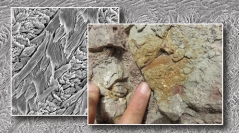

 Geodiversitas
41 (20) - Pages 699-730
Geodiversitas
41 (20) - Pages 699-730Paleogene deposits of Peruvian Amazonia have yielded the oldest caviomorph rodent communities from South America, and the clues that their early diversification had occurred in this area. Here we report fossil dental remains of rodents from two new sections located in the vicinity of Juanjui and Balsayacu (San Martín Department, Peruvian Amazonia). Analyses of the occlusal morphology of cheek teeth and of the incisor enamel microstructure indicate the occurrence of basal caviomorphs (such as Cachiyacuy Antoine, Marivaux, Croft, Billet, Ganerød, Jaramillo, Martin, Orliac, Tejada, Altamirano, Duranthon, Fanjat, Rousse & Salas Gismondi, 2012, Canaanimys Antoine, Marivaux, Croft, Billet, Ganerød, Jaramillo, Martin, Orliac, Tejada, Altamirano, Duranthon, Fanjat, Rousse & Salas Gismondi, 2012, and Eoespina Frailey & Campbell, 2004, genera so far known from late middle Eocene deposits of Contamana, Peruvian Amazonia) in levels situated in the lower part of the studied stratigraphic section. More derived taxa (such as Eoincamys Frailey & Campbell, 2004), known from early Oligocene deposits of Tarapoto/Shapaja and Santa Rosa, Peruvian Amazonia) occur only in upper levels of the section. Based on these considerations, the rodent-bearing localities of the Juanjui/Balsayacu area seem to be intermediate in age between the Contamana Eocene localities and the Tarapoto/Shapaja Oligocene ones and the Santa Rosa ?Eocene/Oligocene one. These new data document a poorly known period in Western Amazonia, in providing a sedimentological record most likely documenting the late middle Eocene, the late Eocene and the earliest Oligocene interval. Furthermore, the existence of a long temporal hiatus between Canaanimys-Cachiyacuy-Potamotrygon ucayalensis assemblages (Contamana, Pozo Formation; Balsayacu; lower levels at Juanjui) and Eoincamys-yielding faunas (Santa Rosa; Tarapoto/Shapaja; uppermost levels at Juanjui) is demonstrated in a single continuous and long-ranging stratigraphic section at Juanjui.
Peru, Eocene, Oligocene, Caviomorpha, dental morphology, biostratigraphy, enamel microstructure